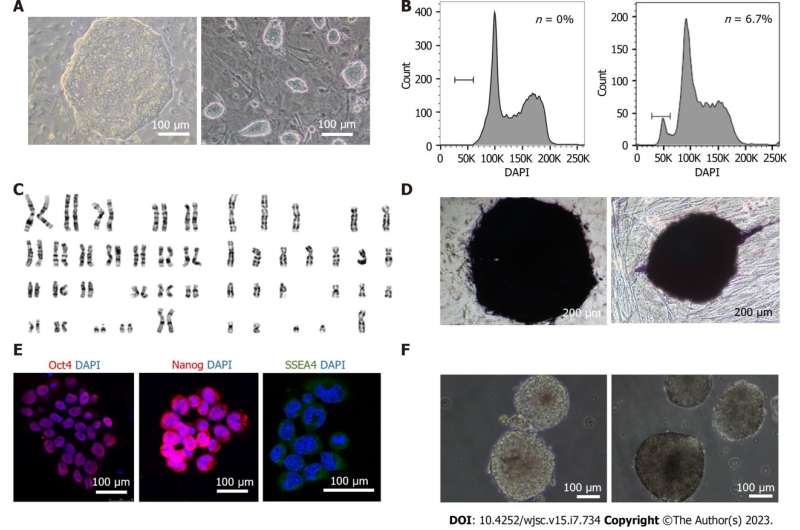
Characterization of the pluripotency and haploidy of extended pluripotent human haploid embryonic stem cells. Credit: World Journal of Stem Cells (2023). DOI: 10.4252/wjsc.v15.i7.734
Haploid embryonic stem cells (haESCs) have been established in many species. Differentiated haploid cell line types in mammals are lacking due to spontaneous diploidization during differentiation that compromises lineage-specific screens.
Recently, a research team set out to derive human haploid neural stem cells (haNSCs) to carry out lineage-specific screens. The research is published in the World Journal of Stem Cells.
Human haNSCs were differentiated from human extended haESCs with the help of Y27632 (ROCK signaling pathway inhibitor) and a series of cytokines to reduce diploidization. Neuronal differentiation of haNSCs was performed to examine their neural differentiation potency. Global gene expression analysis was con-ducted to compare haNSCs with diploid NSCs and haESCs. Fluorescence activated cell sorting was performed to assess the diploidization rate of extended haESCs and haNSCs. Genetic manipulation and screening were utilized to evaluate the significance of human haNSCs as genetic screening tools.
Human haESCs in extended pluripotent culture medium showed more compact and smaller colonies, a higher efficiency in neural differentiation, a higher cell survival ratio and higher stability in haploidy maintenance. These characteristics effectively facilitated the derivation of human haNSCs.
These human haNSCs can be generated by differentiation and maintain haploidy and multipotency to neurons and glia in the long term in vitro. After PiggyBac transfection, there were multiple insertion sites in the human haNSCs’ genome, and the insertion sites were evenly spread across all chromosomes. In addition, after the cells were treated with manganese, we were able to generate a list of manganese-induced toxicity genes, demonstrating their utility as genetic screening tools.
This is the first report of a generated human haploid somatic cell line with a complete genome, proliferative ability and neural differentiation potential that provides cell resources for recessive inheritance and drug targeted screening.
Human embryonic stem cells are widely used in preclinical and genetic screening studies. Haploid cells are ideal tools to perform genetic screening. To date, no human haploid somatic cell lines have been successfully created. The researchers converted human haploid embryonic stem cells to an extended pluripotency state by optimizing the culture medium. The derived haploid neural stem cells can proliferate as a haploid genome and maintain multipotency to generate functional neurons and glia. The haploid neural stem cells can also be easily used for gene editing to generate numerous homozygous mutations for lineage-specific screens.
More information:
Hai-Song Wang et al, Generation of a human haploid neural stem cell line for genome-wide genetic screening, World Journal of Stem Cells (2023). DOI: 10.4252/wjsc.v15.i7.734
Provided by
World Journal of Stem Cells
Citation:
Generation of a human haploid neural stem cell line for genome-wide genetic screening (2023, July 26)
retrieved 26 July 2023
from https://phys.org/news/2023-07-generation-human-haploid-neural-stem.html
This document is subject to copyright. Apart from any fair dealing for the purpose of private study or research, no
part may be reproduced without the written permission. The content is provided for information purposes only.
>>> Read full article>>>
Copyright for syndicated content belongs to the linked Source : Phys.org – https://phys.org/news/2023-07-generation-human-haploid-neural-stem.html
